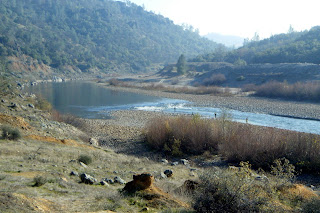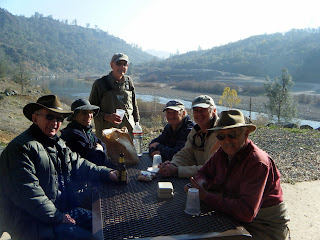Gold Country Fly Fishers
GCFF Fish Outs and Clinics for,
March 2012

_____________________________________________________________
Gold Country Fly Fishers Programs for February 2012.
The Gold Country Fly Fishers is introducing an ambitious program for 2012. For February we have a Fish Out Scheduled at Pyramid Lake, 2 Fly Casting Workshops and 1 Techniques Clinic
__________________________________________________________________
Fish Outs
The GCFF Fish Outs are fishing opportunities to enable all members to experience our local and Nouthern California fly fishing destinations and meet new fly fishing friends. The GCFF Fish Outs are open to all members. To insure this the GCFF Board has requested that if an outing is limited to a maximum number of participants and if there are more signees than the outing can handle, a lottery will be held to determine the members than will attend. The GCFF goal is to provide opportunities to all of its members.
Fish Outs
The GCFF Fish Outs are fishing opportunities to enable all members to experience our local and Nouthern California fly fishing destinations and meet new fly fishing friends. The GCFF Fish Outs are open to all members. To insure this the GCFF Board has requested that if an outing is limited to a maximum number of participants and if there are more signees than the outing can handle, a lottery will be held to determine the members than will attend. The GCFF goal is to provide opportunities to all of its members.
__________________________________________________________________
The Pyramid lake Outing provided pretty tough fishing for the attendees, but David Bear managed to get 4 in three days. Ed Tom caught a few more, as always. David Bear talked to a guy that was at Pyramid for 10 days to cover the 2-weekend tournament and he said things picked up last Saturday after another storm. We had about 12 club members for two days (last Tue/Wed) and almost everyone caught something. The fish were not in the shallows as is usual for this time of year. Black wooly buggers with some red & blue flash, red copper johns. Water levels are still high - making the ladder fishing more of a challenge. It snowed on Wednesday early AM and rough water kept everyone of the water until 11:00 AM - then pretty flat water. Cheers to our hardy anglers!
__________________________________________________________________Luk Lake Fishout at Clear Creek Casino - March 8th and 9th
Frank Rinella will host the Luk Lake Fishout this year again. Luk Lake is over 65 acres in size, with numerous coves, peninsulas and weed beds. The thick shoreline weeds provide ample cover and vegetation for the lake’s resident bass and sunfish, and also provide food for cruising rainbow trout in the wintertime. Trout fishermen fins that drifting small midge dry flies and midge clusters can be productive throughout the wintertime, as well as dead drifting midge patterns under indicators. Stripping small streamers and damselfly nymphs can be very productive and also creates possibilities to catch bass.
The Clear Creek “Luk Lake” fish out will have an estimated cost of $175 per attendee. This fee includes a day and a half rod fee, lunch on Thursday, breakfast on Friday, and lunch on Friday. The group will have dinner on Thursday night at the Clear Creek Casino. The cost of this dinner is not included in the $175 fee.
It also includes lodging at the Luk Lake Lodge. The lodge is just a short drive (approximately 1/3 mile) away from the lake. The Lodge at Luk Lake is a 5 bedroom, 2 bath ranch-style building featuring 11 beds (4 bedrooms with two twin beds each and one room with 3 twin beds), kitchen and comfortable sitting room. The lodge will sleep a maximum of 12 people.
______________________________________________________________
Mike and Todd Williams will be hosting a stillwater fish out at Scotts Flat Lake instead of at Collins Lake on Monday, March 19th. A short stillwater clinic will be offered first thing at the lake and a BBQ lunch for the attendees. Mike and Todd fished Collins Lake recently and the water has deteriorated. Mike and Todd will keep every one posted as we get closer.

Where: Scotts Flat Lake
Fish Out Leaders:
Mike and Todd Williams
When: Monday, March 19th
What to Expect: A Good Time By All!
Sign Me Up for the Scotts Flat Lake Fish Out
_________________________________________________________
Henderson Springs - April 15th, 16th and 17th
Henderson Springs Trip Full!
 Wayne Holloway is hosting this 3 day trip to Henderson Springs east of Redding. The trip has a maximum numbers of attendees at 13. The cost will be $525 for the 3 days. The payment is die in full by March 6th, 2012. There will be sign-ups for a waiting list for cancellations.
Wayne Holloway is hosting this 3 day trip to Henderson Springs east of Redding. The trip has a maximum numbers of attendees at 13. The cost will be $525 for the 3 days. The payment is die in full by March 6th, 2012. There will be sign-ups for a waiting list for cancellations.Henderson Springs has BIG FISH! so you will not need anything smaller than 3x. For this outing prepare for cold weather. It is typically unsettled at best with wind, snow, rain, sunshine, temperatures in the 30's to 50's. Water temperatures are in the low 50's. The fish are also big and hungry.
Where: Henderson Springs
Fish Out Leader: Wayne Holloway - 916-826-8652 for additional information
When: April 15th, 16th, and 17th, 2012
What to Expect: Big Fish in unsettled weather conditions
___________________________________________________________________
Bob Alvares' Shad Trip
Bob Alvares is the fish master for his Shad Trip. The date has been set at May 11th. Details for this trip will follow.
Use this Email link to reserve a spot.
Sign Me Up for the Shad May Trip
___________________________________________________________________
Clinics, Casting Workshops and Fly Tying
GCFF is ramping up its clinics, casting and fly tying programs for 2012. These programs will be structured for all levels of experience. No one is excluded, everyone is invited. Casting Clinics - March 15th and 31st.
The GCFF Clinicians will provide monthly fly casting workshops for its members in 2012. There will be two classes a month. We will now be offering instruction for all levels at each Fly Casting Workshop. There will be instructors to assist and instruct from beginning to advanced casters. The workshops will be held at Sycamore Ranch County Park and hosted by GCFF Clinicians. This will be a great opportunity to learn to cast and for the more experiened, learn new techniques or fix bad habits. We've all got them!

Casting Clinics Schedule:
The GCFF Clinicians will provide monthly fly casting workshops for its members in 2012. There will be two classes a month. We will now be offering instruction for all levels at each Fly Casting Workshop. There will be instructors to assist and instruct from beginning to advanced casters. The workshops will be held at Sycamore Ranch County Park and hosted by GCFF Clinicians. This will be a great opportunity to learn to cast and for the more experiened, learn new techniques or fix bad habits. We've all got them!
Casting Clinics Schedule:
- Thursday, March 15th - All Levels of Experience Invited - 3:00 to 5:00. Sign me Up for Casting March 15th
- Saturday, March 31st. All Levels of Experience Invited - 10:00 to 12:00. Sign me Up for Casting March 31st
__________________________________________________________________
GCFF Techniques Clinics and Workshops
The GCFF Clinicians will provide Technique Clinics and Workshops for its members in 2012. There will be one or two a month. These clinics and workshops will focus on education and skills development. The technique clinics will be held at Hammon Grove County Park. Come and inprove your knowledge and skills. Sign up early and often!
The GCFF Clinicians will provide Technique Clinics and Workshops for its members in 2012. There will be one or two a month. These clinics and workshops will focus on education and skills development. The technique clinics will be held at Hammon Grove County Park. Come and inprove your knowledge and skills. Sign up early and often!
__________________________________________________________________
March GCFF Techniques Clinics and Workshops
- Saturday, March 31st - 1:00 to 3:00.
- Lower Yuba Techniques Clinic -You can take the skills taught to many Northern California waters. Hosted by GCFF Clinicians. Space will be limited to ensure a quality experience.
- Where: Hammon Grove County Park
- Make sure you have a current CA Fishing License and a Steelhead Report Card
You can email Clay Hash to reserve a spot at the workshops.
Sign me Up for the March 31st Techniques Clinic
Sign me Up for the March 31st Techniques Clinic
__________________________________________________
We will be upgrading our Fly Tying Program. Stay tuned for more information at the next GCFF General Meeting in February.
Thanks, Clay Hash, Fish Outs Chairperson.










